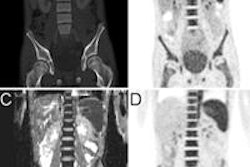Wednesday, December 3 | 3:50 p.m.-4:00 p.m. | SSM02-06 | E451A
Breast biopsy guided by breast-specific gamma imaging (BSGI) is a viable method for biopsying lesions identified at BSGI but overlooked with mammography or ultrasound, according to this Wednesday afternoon presentation.Eric Rupe, from George Washington University Medical Center, and colleagues evaluated the outcomes of BSGI-guided biopsy in women with suspicious BSGI findings. Thirty-eight women had 40 BSGI-guided biopsies between January 2011 and October 2013.
Of the 38 women with 40 suspicious BSGI findings not visible by mammography or ultrasound, BSGI-guided biopsy found eight cancers (20%); five were invasive and three were ductal carcinoma in situ. There were also six cases of atypia (15%) -- for a total of 14 (35%) cancer or high-risk lesions identified, Rupe's team wrote.
"When a lesion is visible by BSGI, and not by mammography or ultrasound, our findings support BSGI-guided biopsy as a reasonable and accurate approach to biopsy the lesion," Rupe and colleagues concluded. "Our results compare favorably to those reported for MR-guided biopsy."





















